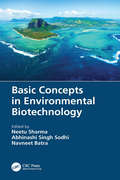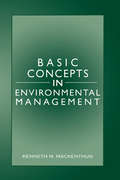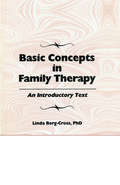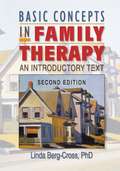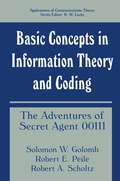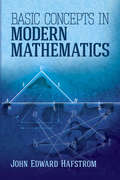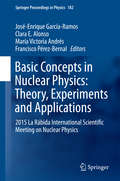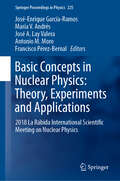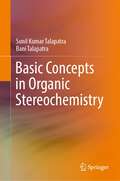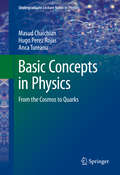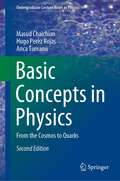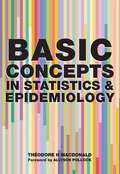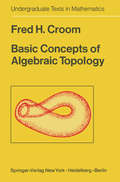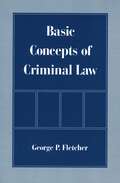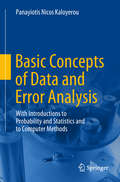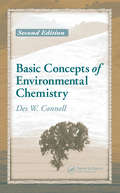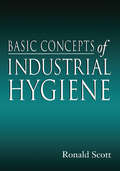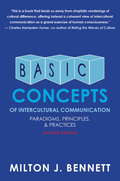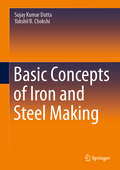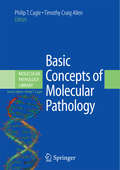- Table View
- List View
Basic Concepts in Environmental Biotechnology
by Neetu Sharma Abhinashi Singh Sodhi Navneet BatraThe book includes current and emerging concepts in the areas of environmental biotechnology such as pollution sources, control and measurement, solid waste management, bioremediation, biofuels, biosensors, bioleaching, conservation biotechnology and more. The book also includes recent innovations made in this field and incorporates case studies to help in understanding the concepts. This book applies principles from multidisciplinary sciences of environmental engineering, metabolic engineering, rDNA technology and omics to study the role of microbes and plants in tackling environmental issues. It also includes content related to risk assessment and environmental management systems. Each chapter provides problems and solutions of different topics with diagrammatic illustrations and tables for students, researchers and other professionals in environmental biotechnology. Explores cutting-edge technologies, including nanotechnology-based bioremediation, value-added products from waste and emerging techniques related to environmental risk assessment and monitoring Reviews the current methods being applied in the environment field for pollution control, waste management, biodegradation of organic and inorganic pollutants and so on Provides in-depth knowledge of the latest advancements in the field of environmental biotechnology such as bioleaching, biomining and advances in biotechnology-based conservation of biodiversity Introduces undergraduate and post-graduate students to basic concepts of environmental biotechnology and allied fields Discusses different products such as biofuels, biopolymers and biosensors that are being produced using biotechnological methods, thus contributing towards the goal of sustainable development Dr. Neetu Sharma is Assistant Professor in the Department of Biotechnology, GGDSD College, Chandigarh, India. The main thrust of her research centers on biotechnology, bioremediation and nanotechnology. Abhinashi Singh Sodhi is Assistant Professor in the Department of Biotechnology, GGDSD College, Chandigarh, India. His current research focuses on waste reduction, valorization and bioproduct formation. Dr. Navneet Batra is Associate Professor and Head, Department of Biotechnology, GGDSD College, Chandigarh, India. He has extensive academic and research experience of over 20 years with specialization in biotechnology and biochemical engineering.
Basic Concepts in Environmental Biotechnology
by Neetu Sharma Abhinashi Singh Sodhi Navneet BatraThe book includes current and emerging concepts in the areas of environmental biotechnology such as pollution sources, control and measurement, solid waste management, bioremediation, biofuels, biosensors, bioleaching, conservation biotechnology and more. The book also includes recent innovations made in this field and incorporates case studies to help in understanding the concepts. This book applies principles from multidisciplinary sciences of environmental engineering, metabolic engineering, rDNA technology and omics to study the role of microbes and plants in tackling environmental issues. It also includes content related to risk assessment and environmental management systems. Each chapter provides problems and solutions of different topics with diagrammatic illustrations and tables for students, researchers and other professionals in environmental biotechnology. Explores cutting-edge technologies, including nanotechnology-based bioremediation, value-added products from waste and emerging techniques related to environmental risk assessment and monitoring Reviews the current methods being applied in the environment field for pollution control, waste management, biodegradation of organic and inorganic pollutants and so on Provides in-depth knowledge of the latest advancements in the field of environmental biotechnology such as bioleaching, biomining and advances in biotechnology-based conservation of biodiversity Introduces undergraduate and post-graduate students to basic concepts of environmental biotechnology and allied fields Discusses different products such as biofuels, biopolymers and biosensors that are being produced using biotechnological methods, thus contributing towards the goal of sustainable development Dr. Neetu Sharma is Assistant Professor in the Department of Biotechnology, GGDSD College, Chandigarh, India. The main thrust of her research centers on biotechnology, bioremediation and nanotechnology. Abhinashi Singh Sodhi is Assistant Professor in the Department of Biotechnology, GGDSD College, Chandigarh, India. His current research focuses on waste reduction, valorization and bioproduct formation. Dr. Navneet Batra is Associate Professor and Head, Department of Biotechnology, GGDSD College, Chandigarh, India. He has extensive academic and research experience of over 20 years with specialization in biotechnology and biochemical engineering.
Basic Concepts in Environmental Management
by Kenneth M. MackenthunEnvironmental professionals are (and will continue to be) under increased pressure to become more knowledgeable of environmental management issues.Basic Concepts in Environmental Management fulfills the long-standing need for fundamental knowledge-especially concerning government regulations on environmental and natural resource protection.As a leading environmental professional and consultant since the 1940s, Kenneth M. Mackenthun offers a unique perspective on the breadth, scope, and ever-constant change in environmental legislation at the federal, state, and local levels... and what those guidelines signify for industry and citizens alike.By maintaining an awareness of existing and forthcoming laws, environmentalists can substantially enhance their career potential-and be in a better position to protect the land, air, and sea. The starting point for that knowledge: Basic Concepts in Environmental Management.
Basic Concepts in Environmental Management
by Kenneth M. MackenthunEnvironmental professionals are (and will continue to be) under increased pressure to become more knowledgeable of environmental management issues.Basic Concepts in Environmental Management fulfills the long-standing need for fundamental knowledge-especially concerning government regulations on environmental and natural resource protection.As a leading environmental professional and consultant since the 1940s, Kenneth M. Mackenthun offers a unique perspective on the breadth, scope, and ever-constant change in environmental legislation at the federal, state, and local levels... and what those guidelines signify for industry and citizens alike.By maintaining an awareness of existing and forthcoming laws, environmentalists can substantially enhance their career potential-and be in a better position to protect the land, air, and sea. The starting point for that knowledge: Basic Concepts in Environmental Management.
Basic Concepts In Fa: An Introductory Text
by Linda Berg CrossFirst published in 1987. Routledge is an imprint of Taylor & Francis, an informa company.
Basic Concepts In Fa
by Linda Berg CrossFirst published in 1987. Routledge is an imprint of Taylor & Francis, an informa company.
Basic Concepts in Family Therapy: An Introductory Text, Second Edition
by Linda Berg CrossGain confidence and creativity in your family therapy interventions with new, up-to-date research!Basic Concepts in Family Therapy: An Introductory Text, Second Edition, presents twenty-two basic psychological concepts that therapists may use to understand clients and provide successful services to them. Each chapter focuses on a single concept using material from family therapy literature, basic psychological and clinical research studies, and cross-cultural research studies. Basic Concepts in Family Therapy is particularly useful to therapists working in a family context with child- or adolescent-referred problems, and for students and clinicians treating the problems they see every day in their community. The book builds on the strengths of the first edition, incorporating ideas and articles that have become worthy of investigating since 1990 into the original text. This new edition also introduces five new chapters on resiliency and poverty, adoption, chronic illness, spirituality and religion, and parenting strategies. The new chapters make the book far more relevant for students and clinicians try ing to use family theory and technique in response to the problems they see in their communities. Basic Concepts in Family Therapy will assist you in offering clients better services by providing a deeper understanding of the contemporary family in its various forms, the psychological bonds that shape all families, and the developmental stages of the family life cycle. This exploration of how family demography, stages and life cycles affect family functions is a solid foundation from which all of the therapeutic concepts in this book can be explored. Some of the facets of family therapy you will explore in Basic Concepts in Family Therapy are: the importance of spirituality and religion in family therapy generational boundaries, closeness, and role behaviors managing a family's emotions defining problems and generating and evaluating possible solutions teaching children specific attitudes, values, social skills, and norms transracial adoptions and normative processes and developmental issues of adoptive parents strategies for reducing conflict . . . and much more!Basic Concepts in Family Therapy will help to broaden your understanding of the ways families function in general. You can use the effective concepts explored in this text to make a thorough assessment of the impact of a disorder on a child and on the rest of his or her family, as well as how family dynamics might have shaped or exacerbated the problems. The concepts described in this text can be customized to clients’cultural values to avoid unnecessary resistance. As a new therapist, you will gain confidence in your assessments, and if you are already a seasoned professional, you will gain creativity in your interventions.
Basic Concepts in Family Therapy: An Introductory Text, Second Edition
by Linda Berg CrossGain confidence and creativity in your family therapy interventions with new, up-to-date research!Basic Concepts in Family Therapy: An Introductory Text, Second Edition, presents twenty-two basic psychological concepts that therapists may use to understand clients and provide successful services to them. Each chapter focuses on a single concept using material from family therapy literature, basic psychological and clinical research studies, and cross-cultural research studies. Basic Concepts in Family Therapy is particularly useful to therapists working in a family context with child- or adolescent-referred problems, and for students and clinicians treating the problems they see every day in their community. The book builds on the strengths of the first edition, incorporating ideas and articles that have become worthy of investigating since 1990 into the original text. This new edition also introduces five new chapters on resiliency and poverty, adoption, chronic illness, spirituality and religion, and parenting strategies. The new chapters make the book far more relevant for students and clinicians try ing to use family theory and technique in response to the problems they see in their communities. Basic Concepts in Family Therapy will assist you in offering clients better services by providing a deeper understanding of the contemporary family in its various forms, the psychological bonds that shape all families, and the developmental stages of the family life cycle. This exploration of how family demography, stages and life cycles affect family functions is a solid foundation from which all of the therapeutic concepts in this book can be explored. Some of the facets of family therapy you will explore in Basic Concepts in Family Therapy are: the importance of spirituality and religion in family therapy generational boundaries, closeness, and role behaviors managing a family's emotions defining problems and generating and evaluating possible solutions teaching children specific attitudes, values, social skills, and norms transracial adoptions and normative processes and developmental issues of adoptive parents strategies for reducing conflict . . . and much more!Basic Concepts in Family Therapy will help to broaden your understanding of the ways families function in general. You can use the effective concepts explored in this text to make a thorough assessment of the impact of a disorder on a child and on the rest of his or her family, as well as how family dynamics might have shaped or exacerbated the problems. The concepts described in this text can be customized to clients’cultural values to avoid unnecessary resistance. As a new therapist, you will gain confidence in your assessments, and if you are already a seasoned professional, you will gain creativity in your interventions.
Basic Concepts in Information Theory and Coding: The Adventures of Secret Agent 00111 (Applications of Communications Theory)
by Solomon W. Golomb Robert E. Peile Robert A. ScholtzBasic Concepts in Information Theory and Coding is an outgrowth of a one semester introductory course that has been taught at the University of Southern California since the mid-1960s. Lecture notes from that course have evolved in response to student reaction, new technological and theoretical develop ments, and the insights of faculty members who have taught the course (in cluding the three of us). In presenting this material, we have made it accessible to a broad audience by limiting prerequisites to basic calculus and the ele mentary concepts of discrete probability theory. To keep the material suitable for a one-semester course, we have limited its scope to discrete information theory and a general discussion of coding theory without detailed treatment of algorithms for encoding and decoding for various specific code classes. Readers will find that this book offers an unusually thorough treatment of noiseless self-synchronizing codes, as well as the advantage of problem sections that have been honed by reactions and interactions of several gen erations of bright students, while Agent 00111 provides a context for the discussion of abstract concepts.
Basic Concepts in Modern Mathematics (Dover Books on Mathematics)
by John Edward HafstromAn in-depth survey of some of the most readily applicable essentials of modern mathematics, this concise volume is geared toward undergraduates of all backgrounds as well as future math majors. By focusing on relatively few fundamental concepts, the text delves deeply enough into each subject to challenge students and to offer practical applications.The opening chapter introduces the program of study and discusses how numbers developed. Subsequent chapters explore the natural numbers; sets, variables, and statement forms; mappings and operations; groups; relations and partitions; integers; and rational and real numbers. Prerequisites include high school courses in elementary algebra and plane geometry.
Basic Concepts in Nuclear Physics: 2015 La Rábida International Scientific Meeting on Nuclear Physics (Springer Proceedings in Physics #182)
by José-Enrique García-Ramos Clara E. Alonso María Victoria Andrés Francisco Pérez-BernalThis volume covers invited papers presented during the La Rábida 2015 International Scientific Meeting on Nuclear Physics, which can be considered heir of a well known series of triennial international summer schools on Nuclear Physics organized from 1982 till 2003 by the Basic Nuclear Physics group in the University of Sevilla. The La Rábida 2015 meeting offered to graduate students and young researchers a broad view of the field of Nuclear Physics. The first invited speaker presented the state-of-the-art of Relativistic Mean Field calculations. The second set of notes covers selected topics in gamma ray spectroscopy with exotic nuclei. The third speaker presented an introduction to the subject of severe accidents in nuclear power plants. In the fourth set of notes, the author illustrated how to use laser spectroscopy to determine very important observables of atomic nuclei. The fifth speaker devoted its notes to explain several aspects of neutrino physics. Finally, the sixth speaker presented an overview of nuclear medicine and radiodiagnostic. In addition to this, the inclusion of the posters and seminars presented by the students gives a fresh and ample perspective on the many different problems of interest nowadays for the Nuclear Physics community.
Basic Concepts in Nuclear Physics: 2018 La Rábida International Scientific Meeting on Nuclear Physics (Springer Proceedings in Physics #225)
by José-Enrique García-Ramos María V. Andrés José A. Lay Valera Antonio M. Moro Francisco Pérez-BernalThis book features material presented at the La Rábida 2018 International Scientific Meeting on Nuclear Physics, which was based on a well-known series of triennial international summer schools on Nuclear Physics organized from 1982 to 2003 by the Basic Nuclear Physics group at the University of Seville and latter, from 2009 to 2018, by the University of Seville and the University of Huelva. The meeting offered graduate students and young researchers a broad overview of the field of nuclear physics.The book includes contributions from invited speakers on topics such as a state-of-the-art nuclear shell model and selected aspects of mass spectroscopy. Other chapters present an introduction to shell model, a review of experimental nuclear reactions, a discussion of the theory of nuclear reactions and an overview of nuclear medicine. Further, the posters and seminars presented by students offer fresh perspectives on various problems current in nuclear physics.
Basic Concepts in Organic Stereochemistry
by Sunil Kumar Talapatra Bani TalapatraThis book discusses essential stereochemical concepts associated with organic molecules (natural or synthetic), as reflected in the course of their many reactions, their mechanisms, their asymmetric synthesis, biosynthesis, and biological activities. This treatise provides useful insights and understanding of the chiral/achiral designations (nomenclatures), the stereochemical features, and related properties of the natural and synthetic products. Without having an adequate knowledge of stereochemical concepts, it will not be possible to understand and appreciate the stereochemistry of natural or synthetic products. Thus, essential static and dynamic aspects of stereochemistry with sufficient illustrative examples along with discussions are presented. The structure of the monograph allows for easy selection of separate topics for reading and teaching. This book will also provide an idea of basic stereochemical concepts, as applied to organic molecules in general as well as to organic ligands in coordination complexes, and will, therefore, be valuable resources to teachers and students of advanced undergraduates and post-graduates, researchers, and professionals.
Basic Concepts in Physics: From the Cosmos to Quarks (Undergraduate Lecture Notes in Physics)
by Masud Chaichian Hugo Perez Rojas Anca Tureanu"Basic Concepts in Physics: From the Cosmos to Quarks" is the outcome of the authors' long and varied teaching experience in different countries and for different audiences, and gives an accessible and eminently readable introduction to all the main ideas of modern physics. The book’s fresh approach, using a novel combination of historical and conceptual viewpoints, makes it ideal complementary reading to more standard textbooks. The first five chapters are devoted to classical physics, from planetary motion to special relativity, always keeping in mind its relevance to questions of contemporary interest. The next six chapters deal mainly with newer developments in physics, from quantum theory and general relativity to grand unified theories, and the book concludes by discussing the role of physics in living systems. A basic grounding in mathematics is required of the reader, but technicalities are avoided as far as possible; thus complex calculations are omitted so long as the essential ideas remain clear. The book is addressed to undergraduate and graduate students in physics and will also be appreciated by many professional physicists. It will likewise be of interest to students, researchers and teachers of other natural sciences, as well as to engineers, high-school teachers and the curious general reader, who will come to understand what physics is about and how it describes the different phenomena of Nature. Not only will readers of this book learn much about physics, they will also learn to love it.
Basic Concepts in Physics: From the Cosmos to Quarks (Undergraduate Lecture Notes in Physics)
by Masud Chaichian Anca Tureanu Hugo Perez RojasThis book is the second edition of an excellent undergraduate-level overview of classical and modern physics, intended for students of physics and related subjects, and also perfectly suited for the education of physics teachers. The twelve-chapter book begins with Newton’s laws of motion and subsequently covers topics such as thermodynamics and statistical physics, electrodynamics, special and general relativity, quantum mechanics and cosmology , the standard model and quantum chromodynamics. The writing is lucid, and the theoretical discussions are easy to follow for anyone comfortable with standard mathematics.An important addition in this second edition is a set of exercises and problems, distributed throughout the book. Some of the problems aim to complement the text, others to provide readers with additional useful tools for tackling new or more advanced topics. Furthermore, new topics have been added in several chapters; for example, the discovery of extra-solar planets from the wobble of their mother stars, a discussion of the Landauer principle relating information erasure to an increase of entropy, quantum logic, first order quantum corrections to the ideal gas equation of state due to the Fermi-Dirac and Bose-Einstein statistics. Both gravitational lensing and the time-correction in geo-positioning satellites are explained as theoretical applications of special and general relativity. The discovery of gravitational waves, one of the most important achievements of physical sciences, is presented as well. Professional scientists, teachers, and researchers will also want to have this book on their bookshelves, as it provides an excellent refresher on a wide range of topics and serves as an ideal starting point for expanding one’s knowledge of new or unfamiliar fields. Readers of this book will not only learn much about physics, they will also learn to love it.
Basic Concepts in Statistics and Epidemiology
by Theodore H. MacDonald Denis Pereira GrayThis book contains a Foreword by Allyson Pollock, Professor and Head, Centre for International Public Health Policy, University of Edinburgh. Healthcare students, practitioners and researchers need a sound basis for making valid statistical inferences from health data. To make the best use of statistical software, it is necessary to understand how probabilistic inference works. This book explains that, along with the various ways statistical data can be described and presented. It is designed to develop insight rather than simply the mechanical skills found in other textbooks. This book is specifically designed to underpin the concepts of statistics and epidemiology. It is practical and easy to use and is ideal for people who can feel uncomfortable with mathematics. 'Excellent. A great primer for all students and research workers engaged in learning how to use statistical ideas in public health. It sets out the core concepts and explains them clearly, using worked examples as illustration. If followed carefully, the engaged reader should be able to use the standard statistical software packages intelligently and sensitively. It will stimulate the public health student, in whatever context, and new researchers, to approach the enterprise with enhanced confidence in interpreting and coherently explaining their findings.' - Allyson Pollock, in the Foreword.
Basic Concepts of Algebraic Topology (Undergraduate Texts in Mathematics)
by F.H. CroomThis text is intended as a one semester introduction to algebraic topology at the undergraduate and beginning graduate levels. Basically, it covers simplicial homology theory, the fundamental group, covering spaces, the higher homotopy groups and introductory singular homology theory. The text follows a broad historical outline and uses the proofs of the discoverers of the important theorems when this is consistent with the elementary level of the course. This method of presentation is intended to reduce the abstract nature of algebraic topology to a level that is palatable for the beginning student and to provide motivation and cohesion that are often lacking in abstact treatments. The text emphasizes the geometric approach to algebraic topology and attempts to show the importance of topological concepts by applying them to problems of geometry and analysis. The prerequisites for this course are calculus at the sophomore level, a one semester introduction to the theory of groups, a one semester introduc tion to point-set topology and some familiarity with vector spaces. Outlines of the prerequisite material can be found in the appendices at the end of the text. It is suggested that the reader not spend time initially working on the appendices, but rather that he read from the beginning of the text, referring to the appendices as his memory needs refreshing. The text is designed for use by college juniors of normal intelligence and does not require "mathematical maturity" beyond the junior level.
Basic Concepts of Criminal Law
by George P. FletcherIn the United States today criminal justice can vary from state to state, as various states alter the Modern Penal Code to suit their own local preferences and concerns. In Eastern Europe, the post-Communist countries are quickly adopting new criminal codes to reflect their specific national concerns as they gain autonomy from what was once a centralized Soviet policy. As commonalities among countries and states disintegrate, how are we to view the basic concepts of criminal law as a whole? Eminent legal scholar George Fletcher acknowledges that criminal law is becoming increasingly localized, with every country and state adopting their own conception of punishable behavior, determining their own definitions of offenses. Yet by taking a step back from the details and linguistic variations of the criminal codes, Fletcher is able to perceive an underlying unity among diverse systems of criminal justice. Challenging common assumptions, he discovers a unity that emerges not on the surface of statutory rules and case law but in the underlying debates that inform them. Basic Concepts of Criminal Law identifies a set of twelve distinctions that shape and guide the controversies that inevitably break out in every system of criminal justice. Devoting a chapter to each of these twelve concepts, Fletcher maps out what he considers to be the deep structure of all systems of criminal law. Understanding these distinctions will not only enable students to appreciate the universal fundamental ideas of criminal law, but will enable them to understand the significance of local details and variations. This accessible illustration of the unity of diverse systems of criminal justice will provoke and inform students and scholars of law and the philosophy of law, as well as lawyers seeking a better understanding of the law they practice.
Basic Concepts of Data and Error Analysis: With Introductions to Probability and Statistics and to Computer Methods
by Panayiotis Nicos KaloyerouThis introductory textbook explains the concepts and methods of data and error analysis needed for laboratory experiment write-ups, especially physics and engineering experiments. The book contains the material needed for beginning students, e.g., first year university students, college students (enrolled on a certificate or diploma course) and even A-level students. Nevertheless, it also covers the required material for higher year university laboratories, including the final year. Only essential concepts and methods needed for the day-to-day performance of experiments and their subsequent analysis and presentation are included and, at the same time, presented as simply as possible. Non-essential detail is avoided. Chapter five is a stand-alone introduction to probability and statistics aimed at providing a theoretical background to the data and error analysis chapters one to four. Computer methods are introduced in Chapter six. The author hopes this book will serve as a constant reference.
Basic Concepts of Environmental Chemistry
by Des W. ConnellBasic Concepts of Environmental Chemistry, Second Edition provides a theoretical basis for the behavior and biological effects of natural chemical entities and contaminants in natural systems, concluding with a practical focus on risk assessment and the environmental management of chemicals. The text uses molecular properties such as pola
Basic Concepts of Industrial Hygiene
by RonaldM. ScottBasic Concepts of Industrial Hygiene covers the latest and most important topics in industrial hygiene today. The textbook begins with a look at the history and basis for industrial hygiene, which provides students with a foundation for understanding later developments. The book contains an in-depth discussion of new OSHA regulations, such as HAZWOPER and Process Safety, which deal with high hazard situations. It also features a chapter on biological hazards of current concern in health care, including tuberculosis, AIDS, and hepatitis B.
Basic Concepts of Industrial Hygiene
by RonaldM. ScottBasic Concepts of Industrial Hygiene covers the latest and most important topics in industrial hygiene today. The textbook begins with a look at the history and basis for industrial hygiene, which provides students with a foundation for understanding later developments. The book contains an in-depth discussion of new OSHA regulations, such as HAZWOPER and Process Safety, which deal with high hazard situations. It also features a chapter on biological hazards of current concern in health care, including tuberculosis, AIDS, and hepatitis B.
Basic Concepts of Intercultural Communication: Paradigms, Principles, and Practices
by Milton BennettIn the long-awaited second edition of Basic Concepts of Intercultural Communication, Milton J. Bennett provides a comprehensive overview of the field from a constructivist perspective. In addition to his insightful analysis, Bennett offers a full complement of classic readings on the topic of intercultural communication, including:• “Science and Linguistics,” by Benjamin Lee Whorf• “The Power of Hidden Differences,” by Edward T. Hall• “Culture: A Perceptual Approach,” by Marshall R. Singer• “Communication in a Global Village,” by Dean Barlund• “Cultural Identity: Reflections on Multiculturalism,” by Peter S. Adler
Basic Concepts of Iron and Steel Making
by Sujay Kumar Dutta Yakshil B. ChokshiThis book presents the fundamentals of iron and steel making, including the physical chemistry, thermodynamics and key concepts, while also discussing associated problems and solutions. It guides the reader through the production process from start to finish, covers the raw materials, and addresses the types of processes and reactions involved in both conventional and alternative methods. Though primarily intended as a textbook for students of metallurgical engineering, the book will also prove a useful reference for professionals and researchers working in this area.
Basic Concepts of Molecular Pathology (Molecular Pathology Library #2)
by Philip T. Cagle Timothy Craig AllenOver the past two decades there has been an explosion in knowledge about the molecular pathology of human diseases which accelerated with the sequencing of the human genome in 2003. Molecular diagnostics and molecular targeted therapy have contributed to the current concept of personalized patient care that is now routine in many medical centers. As a result, general and subspecialty pathologists, clinical practitioners of all types and radiologists must now have an understanding of the basic concepts of molecular pathology and their role in new diagnostic and therapeutic applications to patient care. The Molecular Pathology Library series was created to bridge the gap between traditional basic science textbooks in molecular biology and traditional medical textbooks for organ-specific diseases. Basic Concepts of Molecular Pathology is designed as a stand-alone book to provide the pathologist, clinician or radiologist with a concise review of the essential terminology, concepts and tools of molecular biology that are applied to the understanding, diagnosis and treatment of human diseases in the age of personalized medicine. Those medical practitioners, residents, fellows and students who need to refer to the terminology and concepts of molecular pathology in their patient care will find the Basic Concepts of Molecular Pathology to be a succinct, portable, user-friendly aid in their practice and studies. The service-based physician will find this handy reference to be valuable at the laboratory benchside, at the patient bedside, at multidisciplinary patient care conferences or as a review for examinations.
